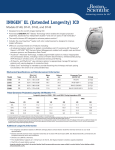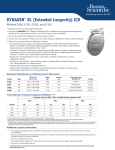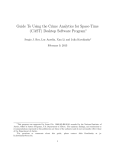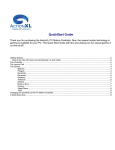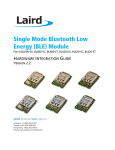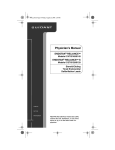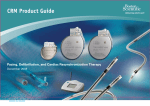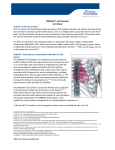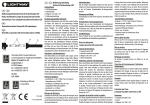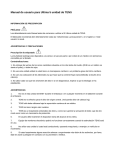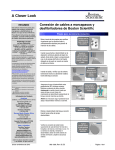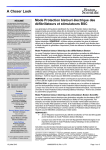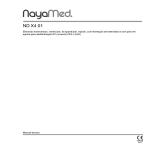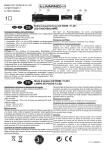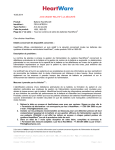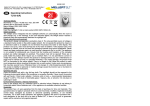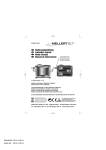Download ICD Brochure - Boston Scientific
Transcript
Patient Comfort In a double blinded study 27 out of 30 ICD patients preferred MINI compared to devices offered by other manufacturers based on size and thinness. The DYNAGEN™, INOGEN™ – ICD from Boston Scientific INDICATIONS AND USAGE: Boston Scientific implantable cardioverter defibrillators (ICDs) are intended to provide ventricular antitachycardia pacing (ATP) and ventricular defibrillation for automated treatment of life-threatening ventricular arrhythmias. CONTRAINDICATIONS: Use of these Boston Scientific pulse generators are contraindicated for the following: patients whose ventricular tachyarrhythmias may have reversible cause, such as: digitalis intoxication, electrolyte imbalance, hypoxia, sepsis; or patients whose ventricular tachyarrhythmias have a transient cause, such as: acute myocardial infarction (MI), electrocution, drowning; or patients who have a unipolar pacemaker. WARNINGS: Read this manual thoroughly before implantation to avoid damage to the pulse generator and/or lead. For single patient use only. Do not reuse, reprocess, or resterilize. Program the pulse generator Tachy Mode(s) to Off during implant, explant, or postmortem procedures to avoid inadvertent high voltage shocks. Always have external defibrillation equipment available during implant and electrophysiologic testing. Ensure that an external defibrillator and medical personnel skilled in CPR are present during post-implant device testing should the patient require external rescue. Patients should seek medical guidance before entering environments that could adversely affect the operation of the active implantable medical device, including areas protected by a warning notice that prevents entry by patients who have a pulse generator. Do not expose a patient to MRI scanning. Do not subject a patient with an implanted pulse generator and/or lead to diathermy. If desired, ensure that Patient Triggered Monitor is enabled prior to sending the patient home. Once the Patient Triggered Monitor feature has been triggered by the magnet and an EGM has been stored, or after 60 days have elapsed from the day that Store EGM was enabled, the patient should not apply the magnet. Do not use this pulse generator with another pulse generator. Do not kink, twist, or braid the lead with other leads as doing so could cause lead insulation abrasion damage or conductor damage. Do not use atrial tracking modes in patients with chronic refractory atrial tachyarrhythmias. Tiny can, huge breakthrough. The world’s smallest and thinnest ICD.1 Boston Scientific provides devices tailored to individual needs. Up to 20% smaller and 24% thinner2 than other ICDs on the market, the MINI offers all the power of a Boston Scientific ICD in a device that is the industry’s sleekest and designed for patient comfort. For leads that require the use of a Connector Tool, use caution handling the lead terminal when the Connector Tool is not present on the lead. Do not directly contact the lead terminal with any surgical instruments or electrical connections such as PSA (alligator) clips, ECG connections, forceps, hemostats, and clamps. Do not contact any other portion of the DF4– LLHH or DF4–LLHO lead terminal, other than the terminal pin, even when the lead cap is in place. PRECAUTIONS: For specific information on precautions, refer to the following sections of the product labeling: clinical considerations, sterilization and storage, implantation, device programming, environmental and medical therapy hazards, hospital and medical environments, home and occupational environments, follow-up testing, explant and disposal, supplemental precautionary information. POTENTIAL ADVERSE EVENTS: Based on the literature and on pulse generator and/or lead implant experience, the following alphabetical list includes the possible adverse events associated with implantation of products described in this literature: air embolism, allergic reaction, bleeding, cardiac tamponade, chronic nerve damage, component failure, conductor coil fracture, death, elevated thresholds, erosion, excessive fibrotic tissue growth, extracardiac stimulation (muscle/nerve stimulation), failure to convert an induced arrhythmia, fluid accumulation, foreign body rejection phenomena, formation of hematomas or seromas, heart block, heart failure following chronic RV apical pacing, inability to defibrillate or pace, inappropriate therapy (e.g., shocks and antitachycardia pacing [ATP] where applicable, pacing), incisional pain, incomplete lead connection with pulse generator, infection including endocarditis, insulating myocardium during defibrillation with internal or external paddles, lead dislodgment, lead fracture, lead insulation breakage or abrasion, lead perforation, lead tip deformation and/or breakage, local tissue reaction, loss of capture, myocardial infarction (MI), myocardial necrosis, myocardial trauma (e.g., tissue damage, valve damage), myopotential sensing, oversensing/undersensing, pacemaker-mediated tachycardia (PMT) (Applies to dual-chamber devices only.), pericardial rub, effusion, pneumothorax, pulse generator migration, shunting current during defibrillation with internal or external paddles, tachyarrhythmias, which include acceleration of arrhythmias and early, recurrent atrial fibrillation, thrombosis/thromboemboli, valve damage, venous occlusion, venous trauma (e.g., perforation, dissection, erosion), worsening heart failure; Patients may develop psychological intolerance to a pulse generator system and may experience the following: dependency, depression, fear of premature battery depletion, fear of shocking while conscious, fear that shocking capability may be lost, imagined shocking, fear of device malfunction. 27 out of 30 preferred MINI Refer to the product labeling for specific indications, contraindications, warnings/precautions and adverse events. Rx only. (Rev. A) Sources: Competitive comparisons: 1 MINI Patient Preference Study, January 2014. Double-blind focus group and questionnaire administered by 3rd party vendor; conducted among 30 device patients. Do you prefer the overall size/shape/thinness of MINI over competitive ICDs? [Yes/No]. Devices tested include the MINI VR ICD, Fortify VR ICD, Ellipse VR ICD, Protecta VR ICD, and Evera VR ICD. Patients care about device size – P HYSICIAN’S TECHNICAL MANUAL DYNAGEN™ EL ICD, DYNAGEN™ MINI ICD, INOGEN™ EL ICD, INOGEN™ MINI ICD, ORIGEN™ EL ICD, ORIGEN™ MINI ICD 2014 page 27-29. – PUNCTUA™ ICD, ENERGEN™ ICD, INCEPTA™ ICD - PHYSICIAN’S TECHNICAL MANUAL 2012 page 40-41. – PROTECTA™ XT VR D314VRM 2013 page 330. – EVERA™ XT VR DVBB1D4 2013 page 24. – A nalyST™, AnalyST Accel™, Current™, Current Accel™, Fortify™, Fortify™ ST, Promote™, Promote Accel™, Promote™ Q, Unify™ Devices User’s Manual 2013 page 29. – St. Jude Medical™ High-Voltage Devices User’s Manual 2013 page 16. – Ilesto 7 Family of ICDs and CRT-Ds Technical Manual 2013 page 217 20% smaller and 24% thinner defined by volume. Comparison of BSC MINI VR ICD and Medtronic EVERA™ XT VR DVBB1D4 2013 page 24. 2 “I’d like it to be really thin. I just don’t want to notice it. I’m going to be concerned about it.” “I get some ache when I lay on my left side. I’d rather have it be smaller.” “Seatbelts bother me so much, it makes me more aware of it.” Based on historical industry average longevity from published sources. 3 Thijssen J, Borleffs CJ, van Rees JB, et al. Implantable cardioverter-defibrillator longevity under clinical circumstances: an analysis according to device type, generation, and manufacturer. Heart Rhythm. April 2012;9(4):513-519. Horlbeck FW, Mellert F, Kreuz J, Nickenig G, Schwab JO. Real-world data on the lifespan of implantable cardioverter-defibrillators depending on manufacturers and the amount of ventricular pacing. J Cardiovasc Electrophysiol. December 2012;23(12):1336-1342. Kallinen L, et al. 2009. http://spo.escardio.org/eslides/view.aspx?eevtid=33&id=1913. Schaer BA, Koller MT, Sticherling C, Altmann D, Joerg L, Osswald S. Longevity of implantable cardioverter defibrillators, influencing factors, and comparison to industry-projected longevity. Heart Rhythm. December 2009;6(12):1737-1743. Knops P, Theuns DA, Res JC, Jordaens L. Analysis of implantable defibrillator longevity under clinical circumstances: implications for device selection. Pacing Clin Electrophysiol. October 2009;32(10):1276-1285. Rhythm Management One Boston Scientific Place Natick, MA 01760-1537 USA www.bostonscientific.com Medical Professionals: 1.800.CARDIAC (227.3422) Patients and Families: 1.866.484.3268 © 2014 Boston Scientific Corporation or its affiliates. All rights reserved. CRM-233722-AA APR2014 MINI Implant Experience History of Innovation The MINI ICD provides up to a 20% reduction in pocket bulk when compared to other devices which can enable: In 1985 we introduced the world’s first ICD… • Smaller incision at initial implant AID B/BR • Easier device replacement • 160cc • Lower risk of pocket revision complications • 30-33 Joules delivered Uncompromised Feature Set Lead Reliability ENDOTAK RELIANCETM Lead Family maintains the same core design elements that have made Boston Scientific the leader in ICD lead reliability for the past 20 years. • Longevity of 1-2 years • No programmability ICD Appropriate Therapy Volume Thinness Boston Scientific MINI 26.5cc 9.9mm Boston Scientific INCEPTA, ENERGEN 30.5cc 9.9mm Medtronic Evera 33cc 13mm St Jude Ellispse 30cc 12mm Biotronik Ilesto 7 33cc 11mm AcuShockTM Advanced Therapy is designed to help you better understand your patients’ arrhythmias and reduce inappropriate therapy. 160 cc In 2014 we are introducing the world’s smallest and thinnest ICD… Appropriate Pacing RYTHMIQTM and AV SearchTM features + give clinicians options to appropriately manage RV pacing in patients with varying degrees of conduction block. DYNAGEN MINI ICD TM 9.9 mm • 26.5cc • 35 Joules delivered (41 joules stored) Smallest and Thinnest ICD • Standard longevity3 26.5 cc • Uncompromised feature set Diagnostics for HF Management HF PERSPECTIV TM feature provides the only system with a weight alert and an in-can diagnostic measuring respiratory rate, RRT (Respiratory Rate Trend).


